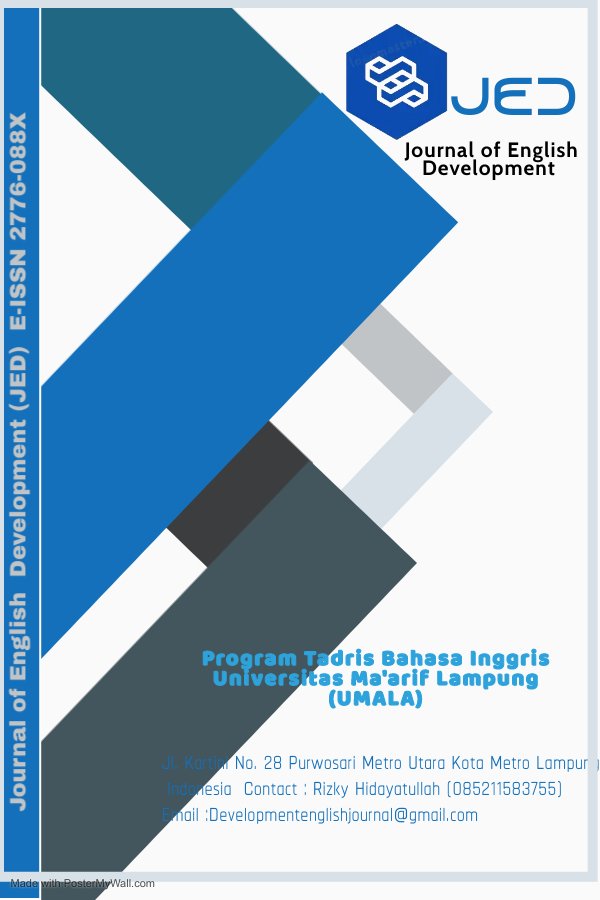The Role of Multisensory Approach in Fostering Student Well-Being in English Language Teaching for Young Learners
English
DOI:
https://doi.org/10.25217/jed.v3i01.4784Keywords:
multisensory, well-being, english young learnersAbstract
This study examined the role of multisensory approaches in enhancing student well-being in learning English as a foreign language (EFL). By integrating multisensory approaches into learning strategies, the study aimed to address language anxiety, a significant barrier for EFL learners. The study used a qualitative library research method to gather and evaluate existing literature and data from diverse sources. It is designed as a qualitative meta-synthesis, which entails gathering and synthesizing qualitative research and theoretical works to uncover major themes and patterns to provide a complete framework for early language teaching methods. The focus on young learners, who often experienced high levels of language anxiety, highlighted the complexity of learning English and the potential of multisensory approaches to mitigate these challenges. The study underscored the importance of considering student well-being in the EFL learning process, suggesting that teachers should incorporate multisensory strategies to enhance language acquisition and overall student well-being. The findings intended to guide curriculum designers, educators, and policymakers, emphasizing the benefits of multisensory approaches in EFL teaching. This research aimed to provide valuable insights for improving English teaching methods and as a foundation for future studies on the impact of multisensory approaches on student well-being and language learning.
References
Al Adzillina, N., & Hasanah, H. U. (2021). The Impact of Multisensory Method on Students’ Memorizing Vocabulary at Halimah Kindergarten Prenduan Sumenep. PANYONARA: Journal of English Education, 3(2), 155–166. https://doi.org/10.19105/panyonara.v3i2.4317
Bago, J. L., Ouédraogo, M., Akakpo, K., Lompo, M. L., Souratié, W. dite M., & Ouédraogo, E. (2020). Early Childhood Education and Child Development: New Evidence from Ghana. Children and Youth Services Review, 108, 104620. https://doi.org/10.1016/j.childyouth.2019.104620
Beisly, A. H., & Lake, V. E. (2021). Knowledge of child development: Associations among pre-service teachers’ level of education and work experience. Journal of Early Childhood Research, 19(2), 195–210. https://doi.org/10.1177/1476718X20942948
Birsh, J. R. (2018). Multisensory Teaching of Basic Language Skills.
Fattokhevna, A. N. (2023). International Journal of Education , Social Science & Humanities . FARS Publishers International Journal of Education , Social Science & Humanities . FARS Publishers. 2, 523–530.
Hartina, S. (2019). Teachers’ Techniques in Teaching English to Young Learners. Indonesian TESOL Journal, 1(1), 78–88. https://doi.org/10.24256/itj.v1i1.538
Jazuly, A., & Indrayani, N. (2018). Guidance of Teaching English to Young Learners (TEYL) for Early Childhood Education Teachers at Ad Dhuha Kindergarten of Jember. Linguistic, English Education and Art (LEEA) Journal, 1(2), 168–179. https://doi.org/10.31539/leea.v1i2.175
Li, S. (2022). On the Role of Teacher-Student Rapport on English as a Foreign Language Students’ Well-Being. Frontiers in Psychology, 12(January), 1–5. https://doi.org/10.3389/fpsyg.2021.822013
Lolita, L., DewI, Y. L. R., & Murti, B. (2019). Multilevel Analysis on the Contextual Effect of the Integrated Health Post Activity on Development of Children Under Five in Kubu Raya, West Kalimantan. Journal of Maternal and Child Health, 4(4), 222–229. https://doi.org/10.26911/thejmch.2019.04.04.01
Manja, S. A., Masnan, A. H., & Mustafa, M. C. (2022). Multisensory Activity In Early Childhood Education : Teachers ’ Perception On The. October. https://doi.org/10.55573/JOSSR.051602
O’Callaghan, C. (2019). A Multisensory Philosophy of Perception. In A Multisensory Philosophy of Perception. https://doi.org/10.1093/oso/9780198833703.001.0001
Oktarina, Y., Inderawati, R., & Petrus, I. (2022). Developing Local Culture-Based EFL Reading Materials for the 21st-Century learning. Studies in English Language and Education, 9(3), 1128–1147. https://doi.org/10.24815/siele.v9i3.24660
Parra G., L. (2021). the Effects of Multisensory Approach in the Development of the Reading Comprehension Skill. 65–73. https://doi.org/10.51508/intcess.202145
Prayatni, I. (2019). Teaching English For Young Learners. Jurnal Ilmiah Profesi Pendidikan, 4(2), 106–110. https://doi.org/10.29303/jipp.v4i2.90
Puspitaloka, N., Syarif, H., & Ermanto. (2021). Teacher’s Perception on How Multisensory Approach in Teaching Reading for EYL with Dyslexia. Proceedings of the Ninth International Conference on Language and Arts (ICLA 2020), 539(Icla 2020), 179–183. https://doi.org/10.2991/assehr.k.210325.033
Ramadani, F. (2022). Developing English language material for high school level using pictures media to improve students speaking skills. Peel (Paser English Education and Linguistic), 1(1), 41–46. https://doi.org/10.56489/peel.v1i1.80
Sarudin, N. A. A., Hashim, H., & Yunus, M. M. (2019). Multisensory Approach: How It Helps in Improving Words Recognition? Creative Education, 10(12), 3186–3194. https://doi.org/10.4236/ce.2019.1012242
Suryaratri, R. D., Prayitno, E. H., & Wuryani, W. (2019). The Implementation of Multisensory Learning at Elementary Schools in Jakarta. JPUD - Jurnal Pendidikan Usia Dini, 13(1), 100–113. https://doi.org/10.21009/10.21009/jpud.131.08
Svitlana, T. (2017). Overcoming Language Anxiety Among the English Language Learners: Psycho-Pedagogical Aspect. Science and Education, 23(7), 102–106. https://doi.org/10.24195/2414-4665-2017-7-16
Syahputri, D. (2019). The Effect of Multisensory Teaching Method on The Students’ Reading Achievement. Budapest International Research and Critics in Linguistics and Education (BirLE) Journal, 2(1), 124–131. https://doi.org/10.33258/birle.v2i1.192
Theresia, N., & Recard, M. (2021). Applying Multisensory Approach To Promote Engagement in Primary English Home-Based Learning. ELTR Journal, 5(2), 105–119. https://doi.org/10.37147/eltr.v5i2.118
Zheng, F. (2022). Fostering Students’ Well-Being: The Mediating Role of Teacher Interpersonal Behavior and Student-Teacher Relationships. Frontiers in Psychology, 12(January). https://doi.org/10.3389/fpsyg.2021.796728

Downloads
Published
How to Cite
Issue
Section
License
Copyright (c) 2024 Anastasia Vena, Yohanes Gatot Sutapa Yuliana, Regina

This work is licensed under a Creative Commons Attribution-ShareAlike 4.0 International License.





